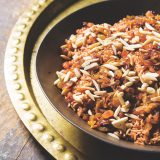For Manal Kahi, a quest for better hummus took a surprising turn—leading to a culinary venture with a refugee-run kitchen.
The Lebanon native was sorely disappointed in the hummus she found when she moved to New York City, so she made her own using a recipe from her Syrian grandmother. Her friends devoured it, and Kahi soon discovered that they were just as hungry to learn about Syria’s cooking traditions.
The popularity of her hummus was not simply about the hummus itself—rather, people connected with the story behind it. That was when she realized that her food could offer New Yorkers a new view of Syrian culture, one very different from the images of a war-torn nation that dominated U.S. news reports.
So in 2015, Kahi and her brother, Wissam, co-launched Eat Offbeat, a catering company staffed by refugee chefs. Their ranks have included cooks from Syria, Sri Lanka, Senegal, Afghanistan, Iran, Venezuela and Iraq. “The cuisines we’re representing are still off the beaten path, even in a city as cosmopolitan as New York,” she notes. But beyond introducing customers to new foods, they hope to change the way refugees are perceived. “They are the heroes, they are the ones helping us discover something new and something different, not the other way around,” she says.
Among the menu highlights is a recipe from Iraqi chef Dhuha Jasim called red rice. Featured in Eat Offbeat’s debut cookbook, “The Kitchen Without Borders,” this basmati pilaf is named for the ruddy hue imparted by tomato paste, which also lends savory depth. A rich combination of fragrant fried onions, raisins and almonds further elevates the dish, but its distinctively Middle Eastern flavor comes from the seasoning blend known as sabaa baharat.
A Middle Eastern pantry staple whose name translates as “seven spices,” sabaa baharat varies by region (and even by household), but it’s always a rich, aromatic mixture of warming spices. In Lebanon, Kahi notes, home cooks often buy it as a premade mix—and they’re very choosy. “My mother only uses a very specific brand,” she says. “And that’s the one I bring back with me every time I come to the U.S.”
Here in the United States, sabaa baharat can be more elusive (it’s more commonly found as “baharat”), but Kahi has been known to whip up her own when her stockpile runs out. Giving that a try for our own adaptation of Jasim’s red rice, we found that a DIY baharat blend of cumin, cardamom, cinnamon, allspice and black pepper worked beautifully. Though our version features only five spices, not the usual seven, we ended up with a delicious dish all the same.






